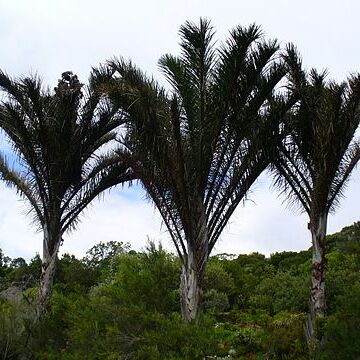Solitary or clustered, acaulescent to erect, massive, hapaxanthic, monoecious palms. Stem, whether short or not, of massive construction, with internodes relatively short, usually covered with rotting leaf-bases and fibres, and often with apogeotropic roots. Leaf reduplicately pinnate, massive (some of the largest leaves in the plant kingdom); leaf-base briefly sheathing, in some species (not in E. Africa) producing broad black fibres (‘piassava’) clothing the stem; petiole short to long; rachis channelled adaxially in proximal region, with 2 lateral grooves accommodating the leaflets in bud; leaflets numerous, crowded, one-fold, arranged in 1–several planes; leaflets in most species spiny along margins and/or midvein, usually with abundant wax on the abaxial surface. Inflorescences produced ± simultaneously in the axils of the most distal, often reduced leaves or bracts, erect or pendulous; axis of the inflorescence bearing a prophyll and several empty tubular bracts, followed by subdistichous or faintly 4-ranked bracts each subtending a first order branch; first order branches each with a basal prophyll and several empty tubular bracts followed by subdistichous or faintly 4-ranked bracts each subtending a rachilla; rachillae tending to lie ± in the same plane, each with a basal prophyll and several empty bracts followed by distichous tubular bracts each subtending a flower, female flowers in the proximal 1/4–3/4 of the rachilla, male flowers in the distal portion, rarely 1–2 bracts subtending a pair, one male and one female; each flower enclosed within a 2-keeled prophyll, and in the instance of the female flower, with a second tubular bracteole. Male flower with tubular scarcely 3-lobed calyx; corolla tubular below, with 3 free lobes above; stamens 6–20 or more, briefly epipetalous and usually connate by their fleshy filaments to some degree; pistillode sometimes present, minute. Female flower with tubular 3-lobed calyx; corolla tubular below with 3 free petals above; staminodal ring present, epipetalous, with sterile flattened, sagittate anthers; pistil with 3 free or connate terminal stigmas; ovary covered with vertical rows of reflexed fimbriate scales; locules 3, each with a single bitegmic, anatropous ovule, normally only 1 ovule developing to maturity. Fruit tipped with the stigmatic remains and covered with the enlarged reflexed scales arranged in vertical rows, each normally with a depressed vertical central line; mesocarp oily. Seed with a moderately thick, rather dry testa and endosperm penetrated by rather large ruminations; embryo lateral. Germination adjacent-ligular; seedling leaf pinnate.
More
Monoecious unarmed pinnate-leaved heavy trees, often soboliferous or growing in clumps in moist or-wet places, monocarpic (plant dying after fruiting): spadices immense in size, interfoliar; the great branches pendent or hanging, 2 m. and more long, thicker than a man's arm, the ultimate stiff or even rigid distichous rachillae 6-10 cm. long and very closely flowered, the long staminate flowers con-spicuously imbedded, stamens 6 and more with erect linear anthers; pistillate flowers larger or at least broader than the staminate, ovoid, the closed body or involucre covered with retrorse scales, staminodia present inside, ovary 3-loculed, stigma sessile; trusses or "hands" of flowers and fruits projecting from beneath hard parchment-like sheathing imbricate scales or spathes that immutably involve the rachis: fruit a loricate oblong or pyriform body 4-6 cm. long, containing within the shell a single oblong nut-like seed ornamented with rapheal lines' and depressions and ruminate inside with prominent intrusions.

